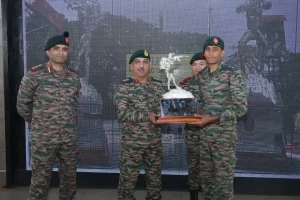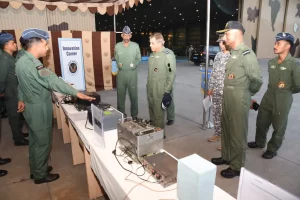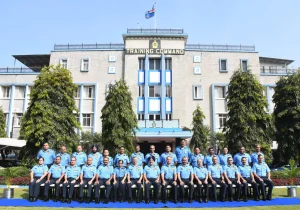Rajnath Singh virtually inaugurates 44 bridges built by BRO in border areas
- As many as 44 bridges built in border areas of Ladakh, Arunachal Pradesh, Sikkim, Himachal Pradesh, Uttarakhand, Punjab and Jammu and Kashmir were dedicated to the nation by Defence Minister Rajnath Singh on Monday.
- Inaugurating the bridges at an online event, the defence minister, in his brief address, referred to the situation along India’s borders with Pakistan and China.
- Most of the 44 bridges, including seven in Ladakh, are in strategically important areas and they will help the armed forces in ensuring quick movement of troops and weapons, officials said.
- The defence minister also symbolically laid the foundation stone of the Nechiphu tunnel in Arunachal Pradesh at the virtual event.
- The inauguration of the bridges built by the Border Roads Organisation comes at a time when India is engaged in a standoff with China in eastern Ladakh.
- Singh sad construction of the bridges will benefit both the civilian population as well as the military in the areas.
- “Our armed forces personnel are deployed in large numbers in areas where transport is not available throughout the year,” he said, noting improvement in border infrastructure will significantly help armed forces.
- “These roads are not only for strategic needs, but they also reflect equal participation of all stakeholders in the development of the nation,” Singh said.
- The defence minister also complimented the Border Roads Organisation (BRO) for working tirelessly even during the coronavirus-triggered lockdown period.
- “The BRO has continued operations in the North Eastern States, Uttarakhand, Himachal Pradesh and union territories of Jammu and Kashmir and Ladakh. BRO continued its work while ensuring that snow clearance is not delayed at remote locations,” he said.
- “I am happy to know that over 2,200 kilometres of roads have been cut by the BRO during the last two years, using the latest technologies, and state-of-the-art equipment. Also, surfacing was carried out on about 4200 km of roads,” he added.
- Amid the border standoff with China, India is expediting work on several key projects including on a strategic road linking Darcha in Himachal Pradesh with Ladakh that will criss-cross a number of high-altitude snow-bound passes.
- The nearly 290-km-long road will be crucial for the movement of troops and heavy weaponry into the frontier bases of the Ladakh region and will provide a crucial link to the Kargil region.
China occupies Nepal territory less than 70 km from India border
- It has been officially confirmed that China has occupied Nepal’s territory and constructed buildings in the Limi region of Humla district, which is situated less than 70 km from Pithoragarh, Uttarakhand.
- On 5 October, a 19-member fact finding team comprising Nepalese politicians and officials, who had gone to Limi to verify the news about Chinese encroachment, found that the Chinese had constructed buildings in the area and had reconstructed border pillar numbers 11, 12 without seeking any permission from Nepal, official sources privy to the development have told The Sunday Guardian.
- Nepal was forced to constitute the fact finding mission after reports in local newspapers and local outrage revealed that the Chinese had intruded into Nepal’s territory and occupied it. In the last week of August, the Nepal government got active and asked for a ground report from the Assistant Chief District Officer of Humla, seeking the details of the encroachment. After the report was submitted, the fact finding team went to the region.
- With news spreading about Chinese encroachment, protests have started at Kathmandu. Political parties and common men protested in front of the Chinese embassy on 28 September. The Sunday Guardian had earlier reported about the salami-slicing technique that China had used to occupy Nepal’s territory (How China salami-sliced an entire Nepal village, 27 June).
- The Nepal government, which does not want to annoy the Chinese government, is now under pressure from the opposition parties to send a team of experts so that the level of Chinese encroachment is ascertained through the use of GPS and strip mapping. However, Prime Minister K.P. Sharma Oli, who is widely seen as pro-Chinese, is still considering how to resolve the issue as once the encroachment is documented through scientific means, then he will have no option but to present it to the Chinese government and seek the return of the encroached territory, which China is claiming as its own.
- “The Chinese, history has shown, are unlikely to let go of the Nepalese territory, something which Oli also understands. This explains the government’s inaction in dealing with this issue, which has been in the media since May-June. Oli does not want to confront the Chinese for reasons best known to him,” a government official said.
10 Terrorists killed in last 5 days, 180 during 75 Successful Operations this year in J-K
- Ten terrorists have been killed in four operations in the last five days, said Dilbag Singh, Director General of Police (DGP), Jammu and Kashmir on Monday adding that this year there have been 75 successful operations in which 180 terrorists have been killed.
- “Ten terrorists killed in four operations in the last five days. One has been surrendered alive who’s a resident of Doda and is being questioned. Today’s operation killed Lashkar-e-Taiba commander Saifullah, a Pakistani who was involved in three major attacks in which three CRPF personnel died,” said Singh while addressing a press conference.
- “This year there have been 75 successful operations in which 180 terrorists have been killed. Separately, 138 terrorists and their associates have been arrested. This year’s operations achievements have set records,” he added.
- A large number of terror associates and active terrorists have been arrested this year, Singh stated.
- “For the first time in the year 2020, Srinagar city has seen eight encounters so far. We have been able to neutralise 18 terrorists so far in these encounters,” said Singh while speaking to a reporter.
- Meanwhile, top terrorist commanders of Lashkar-e-Taiba, Saifullah Danyali, a resident of Pakistan, and Irshad, a resident of Pulwama, neutralised in today’s encounter in Srinagar.
- According to Jammu and Kashmir Police’ official release, as per police records, terrorist Saifullah infiltrated earlier this year and after two months shifted his base from north to south Kashmir.
- He was involved in planning and executing several major terror attacks on security forces which includes the killing of a CRPF officer at Chadoora on September 24, 2020, and two CRPF personnel at Kandizal area of Pampore on October 5, 2020. He was also part of the group involved in killing of two police personnel at Nowgam Srinagar on August 14, 2020. Besides, he was also involved in firing on a convoy on September 21, 2020, in Nowgam area.
Manipur: Security forces recover arms, ammunition in counter-insurgency operations
- Security forces in Manipur recovered a cache of arms and ammunition in separate counter-insurgency operations conducted in the past few days, including along the Indo-Myanmar border.
- With five assembly seats in Manipur scheduled for bye-election on November 7, security has been beefed up in the state, especially in districts where the bypolls are due.
- In the first incident, Assam Rifles troops Thursday launched an operation along the Indo-Myanmar border in Tengnoupal district to stop infiltration of insurgents into from Myanmar. “Based on credible intelligence, on October 8, Assam Rifles troops launched an operation to apprehend insurgents infiltrating across the Indo-Myanmar Border. While approaching the border area, the troops detected suspicious movement of two individuals. Upon being challenged, the two suspected insurgents fled the area towards Myanmar,” a statement by Assam Rifles read.
- Two country-made pistols with live ammunitions and Myanmarese currency were recovered during the operation, the statement added. The recovered items were handed over to Moreh Police Station, it said.
- In another incident, a combined team of Assam Rifles and Manipur Police unearthed a large cache of weapons from Nambol Khathong area of Bishnupur district on Thursday. The joint operation was conducted based on input on the presence of a proscribed insurgent group in the area, sources said.
- An AK-56 Rifle with magazine, two 9mm pistols with magazines, one .32 pistol with magazine, five Lathode bombs, 22 live rounds of AK-56 assault rifle, eight rounds of 9mm, 10 live rounds of .32, nine live rounds of M-16 Rifle, one M-16 rifle grenade and a handheld radio set (Motorola) were recovered during the operation. The recovered weapons and ammunition have been handed over to Nambol police station for further investigation, sources said.
UAE firm selected for carbines in talks with Indian defence majors to set up plant
- The UAE government-owned entity that has been selected for a contract to supply close quarter battle carbines on a fast track basis to the army says that is in talks with major Indian defence players to set up manufacturing facilities from which it can source up to 60% of the components needed.
- Caracal International, which was selected to supply 93, 895 new generation carbines, did not disclose the names of its Indian partners but said that it is willing to transfer technology and move production here, in an exclusive interview.
- As reported, the fast track carbine procurement plan is at a tricky juncture – at a special meeting held last month, chaired by the defence secretary, it was decided that plans in the works since 2018 to import a limited number of close quarter battle carbines to meet immediate requirements are to be shelved in favour of a Make in India plan.
- However, the high-powered Defence Acquisition Council (DAC) still has to ratify the decision and the army has been of the opinion that a larger order for 350,000 carbines can be processed under the Make in India initiative but the fast track procurement of 93, 895 should go ahead due to the urgent nature of the requirement.
- “We already have partners in India who are suppliers that can make more than 60% of the parts. They can make the samples and they can make the parts for us. So, when Caracal wants to move in India, we already have production suppliers and the relationship is there,” said Hamad Salem Al Ameri, chief executive officer, Caracal.
- The executive added that Caracal can move to a 100% Make in India model in the future as well if its government-owned intellectual property (IP) is assured to be protected. “We have already identified all the suppliers for parts and who will do what and at what price. Now, we have a lot of options in India that we are carefully exploring,” he said, adding that the UAE-based company wants to offer its larger range of small arms to the Indian market.
- Responding to questions on communication from the Indian ministry on the status of the contract, Al Ameri said that Caracal has been identified as the lowest bidder and has been waiting for a final decision and that government to government channels have been opened after reports that it could be cancelled.
- “Under CARACAL portfolio, we have more than 14 products for small arms. We are very serious about the Indian market… the relationship between the two nations, the history that we have makes it easy to do,” he said.
- The Indian Army has been without a close quarter battle weapon for years, with officials saying that regular assault rifles are being used for the role, reducing the operational efficiency of troops. While the weapons are particularly useful in anti-terrorist operations, they also have immense utility in border operations where a clash between patrolling troops can take place at close quarters.
- Sources said that the army supports initiatives by the private and public sector in developing these weapons in-house and has started engaging with companies for a larger order of 350,000 rifles that will be fully made in India, with options for exports too.
Lockheed Martin shares new details about hypersonic program
- Pentagon’s No.1 weapons supplier Lockheed Martin Corp has released new details about a hypersonic weapons development in support of the focus in long-range precision strike missiles.
- The U.S. Department of Defense expects that advanced missile and hypersonic vehicle technologies will enhance end-to-end strike force systems, increasing the potential for deterring future threats.
- As noted by the company, as a result of investing in developing and demonstrating Mach 5 technology for over 30 years, Lockheed Martin is at the forefront of operationalizing hypersonic capabilities, systems and engineering.
- According to the company, it is uniquely situated to be able to deliver hypersonic strike systems as well as the ability to detect, track and defeat hypersonic threats.
- “We are developing technology that is incredibly fast and precise to defend the nation and our allies against hypersonic threats,” it said in a statement. “Hypersonic defensive capabilities require a multi-layered approach across all phases of flight detection, tracking and interception. Integration and interoperability are vital elements to connect each layer of this architecture.”
- Currently, Lockheed Martin works on Air-Launched Rapid Response Weapon (ARRW), Intermediate Range Conventional Prompt Strike (IRCPS) and Long-Range Hypersonic Weapon (LRHW) programs.
- The ARRW program matures critical technologies to high speed flight and accelerates the weaponization of Hypersonic strike capabilities. The ARRW program brings corporation-wide experience in design, manufacturing, integration and test, and fielding of complex technologies to customers in the Department of Defense.
- IRCPS is a hypersonic boost glide missile development and test program that enables longer range, shorter time of flight and high survivability against enemy defenses.
- LRHW will leverage the common hypersonic glide body and introduce a new class of ultrafast and maneuverable long-range missiles with the ability to launch from ground mobile platforms.
- The U.S. Air Force and Lockheed Martin already successfully flight tested the second AGM-183A ARRW on the service’s B-52 Stratofortress out of Edwards Air Force Base, California, on Aug. 8, 2020.
- This captive carry flight was conducted with tactical hardware and fully instrumented to collect thermal, mechanical and digital data from the flight vehicle. This is the first time a tactical ARRW missile has been assembled. Additional ground and flight testing will follow over the next two years.
- “The team overcame significant challenges driven by the COVID-19 pandemic to achieve this significant milestone for the program,” said Dave Berganini, ARRW program director at Lockheed Martin Missiles and Fire Control. “This captive carry mission is the pre-cursor for our first booster test flight planned for early 2020s.”
U.S. Navy reveals name of next-generation frigate class
- The U.S. Navy has announced that the new class of frigate will be named Constellation.
- Secretary of the Navy Kenneth J. Braithwaite announced USS Constellation (FFG 62) as the name for the first ship in the new Guided Missile Frigate (FFG(X)) class of ships Oct. 7 while aboard the museum ship Constellation in Baltimore Inner Harbor, according to a recent service news release.
- The name was selected in honor of the first U.S. Navy ships authorized by Congress in 1794 — six heavy frigates named United States, Constellation, Constitution, Chesapeake, Congress, and President. These ships established the Continental Navy as an agile, lethal and ready force for the 19th century. This will be the fifth U.S. Navy ship to bear the name Constellation.
- “As the first in her class, these ships will now be known as the Constellation Class frigates, linking them directly to the original six frigates of our Navy, carrying on the traditions of our great service which have been passed down from generation to generation of Sailors,” said Braithwaite. “While providing an unmatched capability and survivability for the 21st Century, Constellation Class Frigates will honor our Navy’s historic beginnings as we continue to operate around the world in today’s era of Great Power Competition.”
- As the next generation of small surface combatants will contribute to meeting the goal of 355 battle force ships. With the ability to operate independently or as part of a strike group, it will deliver an Enterprise Air Surveillance Radar (EASR), Mk 41 Vertical Launching System, and Baseline 10 (BL 10) Aegis Combat System capabilities. The ships lethality, survivability, and improved capability will provide Fleet Commanders multiple options while supporting the National Defense Strategy across the full range of military operations.
- Constellation is a historic name with a long Naval history. The original name was submitted to President Washington in 1795 to represent the ‘new constellation of stars’ on the United States flag. The first Constellation was a 38-gun frigate with a crew of 340 personnel. The ship was built in Baltimore in 1797 and remained in service until 1853.
- The second Constellation was a sloop-of-war launched in 1854 and was the last sail-only warship designed and built by the U.S. Navy. The ship currently stands as a museum in Baltimore.
- The keel for a third ship named Constellation was laid, but the ship was never completed in the peace years following WWI.
- The most prominent Constellation is the Kitty-Hawk class conventional aircraft carrier that commissioned in 1961. It had a storied history to include overcoming several catastrophic fires on board, supporting operations during the Vietnam War, the first Persian Gulf War, and Operations Enduring and Iraqi Freedom before decommissioning in 2003.
- Constellation Class Frigates will be built at Marinette Marine Corporation in Marinette, Wisconsin with the first ship scheduled for delivery in 2026.
QUICK REVIEW
- Nechiphu tunnel was inaugurated by Rajnath Singh, the Union Minister of Defence, by virtual mode. It is in which state?
- Assam
- Meghalaya
- Tripura
- Arunachal Pradesh
ANSWER: D
- U.S. Navy reveals name of next-generation frigate class as
- Constellation
- Constitution
- Congress
- Chesapeake
ANSWER: A
- Caracal International, has been selected for a contract to supply 93,895 new generation close quarter battle carbines on a fast track basis to the army. It is based in which country?
- UK
- UAE
- USA
- Iran
ANSWER: B



















